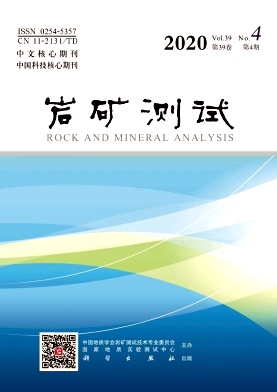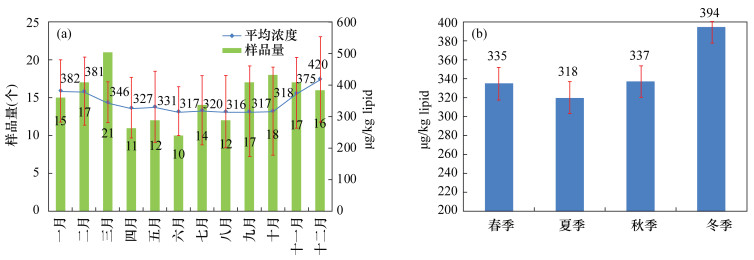| [1] |
Gilio A D, Ventrella G, Giungato P, et al.An intensive monitoring campaign of PAHs for assessing the impact of a steel plant[J].Chemosphere, 2017, 168:171-182. doi: 10.1016/j.chemosphere.2016.10.019
CrossRef Google Scholar
|
| [2] |
Abdel-Shafy H I, Mansour M S M.A Review on polycyclic aromatic hydrocarbons:Source, environmental impact, effect on human health and remediation[J].Egyptian Journal of Petroleum, 2015, 25:107-123.
Google Scholar
|
| [3] |
Amodio M, Andriani E, Dambruoso P R, et al.A monitoring strategy to assess the fugitive emission from a steel plant[J].Atmosphere Environment, 2013, 79:455-461. doi: 10.1016/j.atmosenv.2013.07.001
CrossRef Google Scholar
|
| [4] |
Cakmak S, Hebbern C, Cakmak J D, et al.The influence of polycyclic aromatic hydrocarbons on lung function in a representative sample of the Canadian population[J].Envirnmental Pollution, 2017, 228:1-7. doi: 10.1016/j.envpol.2017.05.013
CrossRef Google Scholar
|
| [5] |
Yang J, Qadeer A, Liu M, et al.Occurrence, source, and partition of PAHs, PCBs, and OCPs in the multiphase system of an urban lake, Shanghai[J].Applied Geochemistry, 2019, 106:17-25. doi: 10.1016/j.apgeochem.2019.04.023
CrossRef Google Scholar
|
| [6] |
Qu C S, Li B, Wu H S.Multi-pathway assessment of human health risk posed by polycyclic aromatic hydrocarbons[J].Environmental Geochemistry and Health, 2015, 37:587-601. doi: 10.1007/s10653-014-9675-7
CrossRef Google Scholar
|
| [7] |
Ruby M V, Lowney Y W, Bunge A L, et al.Oral bioavail-ability, bioaccessibility, and dermal absorption of PAHs from soil-State of the science[J].Environmental Science & Technology, 2016, 50:2151-2164.
Google Scholar
|
| [8] |
Tang J, An T C, Xiong J K, et al.The evolution of pollution profile and health risk assessment for three groups SVOCs pollutants along with Beijiang River, China[J].Environmental Geochemistry and Health, 2017, 39(6):1487-1499. doi: 10.1007/s10653-017-9936-3
CrossRef Google Scholar
|
| [9] |
Sun H W, An T C, Li G Y, et al.Distribution, possible sources, and health risk assessment of SVOC pollution in small streams in Pearl River Delta, China[J].Environmental Science and Pollution Research, 2014, 21(17):10083-10095. doi: 10.1007/s11356-014-3031-4
CrossRef Google Scholar
|
| [10] |
Çok I, Mazmanci B, Mazmanci M A, et al.Analysis of human milk to assess exposure to PAHs, PCBs and organochlorine pesticides in the vicinity Mediterranean city Mersin, Turkey[J].Environment International, 2012, 40:63-69. doi: 10.1016/j.envint.2011.11.012
CrossRef Google Scholar
|
| [11] |
Hou J, Yin W J, Li P, et al.Joint effect of polycyclic aromatic hydrocarbons and phthalates exposure on telomere length and lung function[J].Journal of Hazardous Materials, 2020, 386:121663. doi: 10.1016/j.jhazmat.2019.121663
CrossRef Google Scholar
|
| [12] |
Ye X Q, Pan W Y, Li C M, et al.Exposure to polycyclic aromatic hydrocarbons and risk for premature ovarian failure and reproductive hormones imbalance[J].Journal of Environmental Sciences, 2020, 91:1-9. doi: 10.1016/j.jes.2019.12.015
CrossRef Google Scholar
|
| [13] |
Wang F D, Zhang H J, Geng N B, et al.A metabolomics strategy to assess the combined toxicity of polycyclic aromatic hydrocarbons (PAHs) and short-chain chlorinated paraffins (SCCPs)[J].Environmental Pollution, 2018, 234:572-580. doi: 10.1016/j.envpol.2017.11.073
CrossRef Google Scholar
|
| [14] |
Pinto M, Rebola M, Louro H, et al.Chlorinated polycyclic aromatic hydrocarbons associated with drinking water disinfection:Synthesis, formation under aqueous chlorination conditions and genotoxic effects[J].Polycyclic Aromatic Compounds, 2014, 34:356-371. doi: 10.1080/10406638.2014.891143
CrossRef Google Scholar
|
| [15] |
Farzan S F, Chen Y, Trachtman H, et al.Urinary polycyclic aromatic hydrocarbons and measures of oxidative stress, inflammation and renal function in adolescents:NHANES 2003-2008[J].Environmental Research, 2016, 144:149-157. doi: 10.1016/j.envres.2015.11.012
CrossRef Google Scholar
|
| [16] |
IARC.Some non-heterocyclic polycyclic aromatic hydrocarbons and some related exposures[R]//IARC monographs on the evaluation of carcinogenic risks to humans.WHO IARC, 2010:92.
Google Scholar
|
| [17] |
Bae S, Pan X C, Kim S Y, et al.Exposures to particulate matter and polycyclic aromatic hydrocarbons and oxidative stress in school children[J].Environmental Health Perspectives, 2010, 118:579-583. doi: 10.1289/ehp.0901077
CrossRef Google Scholar
|
| [18] |
Ohura T.Environmental behavior, sources, and effects of chlorinated polycyclic aromatic hydrocarbons[J].Scientific World Journal, 2007, 7:372-380. doi: 10.1100/tsw.2007.75
CrossRef Google Scholar
|
| [19] |
Armstrong B G, Gibbs G.Exposure-response relationship between lung cancer and polycyclic aromatic hydrocarbons (PAHs)[J].Occupational and Environ-mental Medicine, 2009, 66:740-746. doi: 10.1136/oem.2008.043711
CrossRef Google Scholar
|
| [20] |
Zhou Y, Sun H, Xie J, et al.Urinary polycyclic aromatic hydrocarbon metabolites and altered lung function in Wuhan, China[J].American Journal of Respiratory and Critical Care Medicine, 2016, 193:835-846. doi: 10.1164/rccm.201412-2279OC
CrossRef Google Scholar
|
| [21] |
Jedrychowski W A, Perera F P, Maugeri U, et al.Long term effects of prenatal and postnatal airborne PAH exposures on ventilatory lung function of non-asthmatic preadolescent children. Prospective birth cohort study in Krakow[J].Science of the Total Environment, 2015, 502:502-509. doi: 10.1016/j.scitotenv.2014.09.051
CrossRef Google Scholar
|
| [22] |
Padula A M, Balmes J R, Eisen E A, et al.Ambient polycyclic aromatic hydrocarbons and pulmonary function in children[J].Journal of Exposure Science and Environmental Epidemiology, 2015, 25:295-302. doi: 10.1038/jes.2014.42
CrossRef Google Scholar
|
| [23] |
Barraza-Villarreal A, Escamilla-Nunez M C, Schilmann A, et al.Lung function, airway inflammation, and polycyclic aromatic hydrocarbons exposure in Mexican school children:A pilot study[J].Journal of Occupational and Environmental Medicine, 2014, 56:415-419. doi: 10.1097/JOM.0000000000000111
CrossRef Google Scholar
|
| [24] |
Mu G, Fan L Y, Zhou Y, et al.Personal exposure to PM2.5-bound polycyclic aromatic hydrocarbons and lung function alteration:Results of a panel study in China[J].Science of the Total Environment, 2019, 684:458-465. doi: 10.1016/j.scitotenv.2019.05.328
CrossRef Google Scholar
|
| [25] |
Wang L, Li C M, Jiao B N, et al.Halogenated and parent polycyclic aromatic hydrocarbons in vegetables:Levels, dietary intakes, and health risk assessments[J].Science of the Total Environment, 2018, 616-617:288-295. doi: 10.1016/j.scitotenv.2017.10.336
CrossRef Google Scholar
|
| [26] |
Sun J L, Zeng H, Ni H G.Halogenated polycyclic aromatic hydrocarbons in the environment[J].Chemosphere, 2013, 90:1751-1759. doi: 10.1016/j.chemosphere.2012.10.094
CrossRef Google Scholar
|
| [27] |
Sun J L, Ni H G, Zeng H.Occurrence of chlorinated and brominated polycyclic aromatic hydrocarbons in surface sediments in Shenzhen, South China and its relationship to urbanization[J].Journal of Environmental Monitoring, 2011, 13:2775-2781. doi: 10.1039/c1em10465a
CrossRef Google Scholar
|
| [28] |
Hong Q, Li W L, Zhu N Z, et al.Concentrations and sources of polycyclic aromatic hydrocarbons in indoor dust in China[J].Science of the Total Environment, 2014, 491-492:100-107. doi: 10.1016/j.scitotenv.2014.01.119
CrossRef Google Scholar
|
| [29] |
Sun J L, Jing X, Chang W J, et al.Cumulative health risk assessment of halogenated and parent poly-cyclic aromatic hydrocarbons associated with particulate matters in urban air[J].Ecotoxicology and Environmental Safety, 2015, 113:31-37. doi: 10.1016/j.ecoenv.2014.11.024
CrossRef Google Scholar
|
| [30] |
Ding C, Ni H G, Zeng H.Parent and halogenated polycyclic aromatic hydrocarbons in rice and implications for human health in China[J].Environmental Pollution, 2012, 168:80-86. doi: 10.1016/j.envpol.2012.04.025
CrossRef Google Scholar
|
| [31] |
Santonicola S, Felice A D, Cobellis L, et al.Comparative study on the occurrence of polycyclic aromatic hydrocarbons in breast milk and infant formula and risk assessment[J].Chemosphere, 2017, 175:383-390. doi: 10.1016/j.chemosphere.2017.02.084
CrossRef Google Scholar
|
| [32] |
Pulkrabova J, Stupak M, Svarcova A, et al.Relationship between atmospheric pollution in the residential area and concentrations of polycyclic aromatic hydrocarbons (PAHs) in human breast milk[J].Science of the Total Environment, 2016, 562:640-647. doi: 10.1016/j.scitotenv.2016.04.013
CrossRef Google Scholar
|
| [33] |
Luzardo P O, Ruiz-Suárez N, Almeida-González M, et al.Multi-residue method for the determination of 57 persistent organic pollutants in human milk and colostrum using a QuEChERS-based extraction procedure[J].Analytical and Bioanalytical Chemistry, 2013, 405:9523-9536. doi: 10.1007/s00216-013-7377-0
CrossRef Google Scholar
|
| [34] |
Kishikawa N, Wada M, Kuroda N, et al.Determination of polycyclic aromatic hydrocarbons in milk samples by high-performance liquid chromatography with fluore-scence detection[J].Journal of Chromatography B, 2003, 789:257-264. doi: 10.1016/S1570-0232(03)00066-7
CrossRef Google Scholar
|
| [35] |
Yu Y X, Wang X L, Wang B, et al.Polycyclic aromatic hydrocarbon residues in human milk, placenta, and umbilical cord blood in Beijing, China[J].Environmental Science & Technology, 2011, 45:10235-10242.
Google Scholar
|
| [36] |
Song S L, Ma X D, Pan M, et al.Excretion kinetics of three dominant organochlorine compounds in human milk within the first 6 months postpartum[J].Environmental Monitoring and Assessment, 2018, 190:457. doi: 10.1007/s10661-018-6850-9
CrossRef Google Scholar
|
| [37] |
Kim S, Halden R, Buckley T J.Polycyclic aromatic hydrocarbons in human milk of nonsmoking U.S.women[J].Environmental Science & Technology, 2008, 42:2663-2667.
Google Scholar
|
| [38] |
Tsang H L, Wu S C, Leung C K M, et al.Body burden of POPs of Hong Kong residents, based on human milk, maternal and cord serum[J].Environment International, 2011, 37:142-151. doi: 10.1016/j.envint.2010.08.010
CrossRef Google Scholar
|
| [39] |
Wang L, Liu A P, Zhao Y, et al.The levels of polycyclic aromatic hydrocarbons (PAHs) in human milk and exposure risk to breastfed infants in petrochemical industrialized Lanzhou Valley, northwest China[J].Environmental Science and Pollution Research, 2018, 25(9):1-13.
Google Scholar
|
| [40] |
Xu S, Liu W, Tao S.Emission of polycyclic aromatic hydrocarbons in China[J].Environmental Science & Technology, 2006, 40:702-708.
Google Scholar
|
| [41] |
Yu Y X, Li Q, Wang H, et al.Risk of human exposure to polycyclic aromatic hydrocarbons:A case study in Beijing, China[J].Environmental Pollution, 2015, 205:70-77. doi: 10.1016/j.envpol.2015.05.022
CrossRef Google Scholar
|
| [42] |
Zhang Y J, Lin Y, Cai J, et al.Atmospheric PAHs in North China:Spatial distribution and sources[J].Science of the Total Environment, 2016, 565:994-1000. doi: 10.1016/j.scitotenv.2016.05.104
CrossRef Google Scholar
|
| [43] |
王英锋, 张姗姗, 李杏茹, 等.北京大气颗粒物中多环芳烃浓度季节变化及来源分析[J].环境化学, 2010, 29(3):369-375.
Google Scholar
Wang Y F, Zhang S S, Li X R, et al.Seasonnal variation and source identification of polycyclic aromatic hydrocarbons (PAHs) in airborne particulates of Beijing[J].Environmental Chemistry, 2010, 29(3):369-375.
Google Scholar
|
| [44] |
董雪玲, 刘大锰, 袁杨鬙, 等.北京市大气PM10和PM2.5中有机物的时空变化[J].环境科学, 2009, 30(2):328-332.
Google Scholar
Dong X L, Liu D M, Yuan Y S, et al.Spatial-temporal variations of extractable organic matters in atmospheric PM10 and PM2.5 in Beijing[J].Environmental Science, 2009, 30(2):328-332.
Google Scholar
|
| [45] |
张秀川, 赵健, 王婷, 等.2014年北京市某区不同空气质量下大气颗粒物中多环芳烃的特征与来源分析[J].环境卫生学杂志, 2019, 9(2):97-102.
Google Scholar
Zhang X C, Zhao J, Wang T, et al.Characteristics and sources analysis of polycyclic aromatic hydrocarbons in atmosphere particulate matters under different air quality in a district of Beijing in 2014[J].Journal of Environmental Hygiene, 2019, 9(2):97-102.
Google Scholar
|
| [46] |
Achary N, Gautam B, Subbiah S, et al.Polycyclic aromatic hydrocarbons in breast milk of obese vs normal women:Infant exposure and risk assessment[J].Science of the Total Environment, 2019, 668:658-667. doi: 10.1016/j.scitotenv.2019.02.381
CrossRef Google Scholar
|
| [47] |
US EPA.Polycyclic organic matter.http://www.epa.gov/ttnatw01/hlthef/polycycl.html[EB/OL]. Washington D.C.: Environmental Protection Agency, 2002.
Google Scholar
|
| [48] |
Tue N M, Sudaryanto A, Minh T B, et al.Kinetic differences of legacy organochlorine pesticides and polychlorinated biphenyls in Vietnamese human breast milk[J].Chemosphere, 2010, 81(8):1006-1011. doi: 10.1016/j.chemosphere.2010.09.013
CrossRef Google Scholar
|
| [49] |
van Oostdam J, Gilman A, Dewailly E, et al.Human health implications of environmental contaminants in Arctic Canada:A review[J].Science of the Total Environment, 1999, 230:1-82. doi: 10.1016/S0048-9697(99)00036-4
CrossRef Google Scholar
|







 DownLoad:
DownLoad: